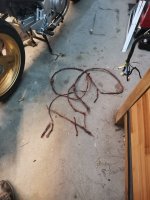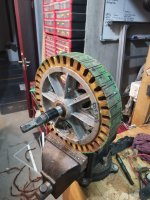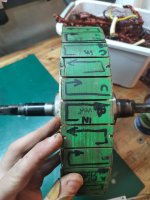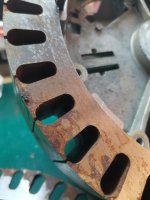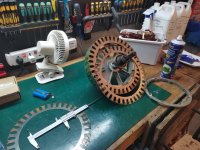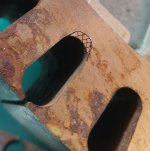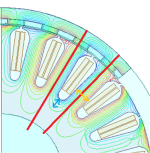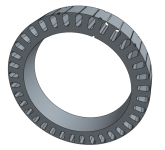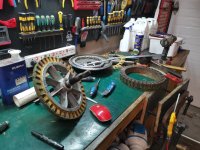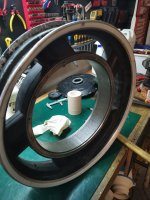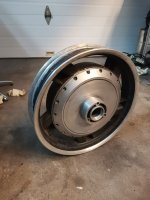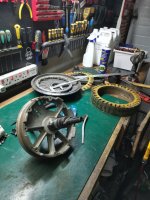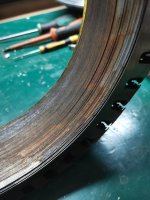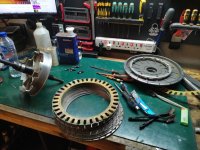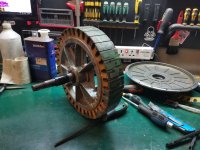Dui ni shuo de dui
10 kW
Hello everyone,
A good friend of mine unfortunately fried his motor recently. It looks like one of the phase partially melted down.
He dropped the motor off to my place yesterday and now I'm trying to see if I can rewire it.
That would be my first time attempting this task, so I thought I'd come here to pick some clever folks brains in order to get as many useful information as possible before trying the rewinding process.
It's a QS 273 rated at 8000W. The goal is to try to make it as powerful as it used to be, or, if possible, even better.
Right now I've started the process of unwinding it, in order to get as many information as I can on its original configuration.
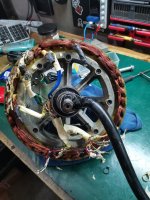
So far it seems like it has 3 turns per tooth, 54 paralleled wires, each of the wires measuring 0.54mm in diameter.
I'm taking notes of the turns orientation and phases numbers by marking them directly on the laminations:
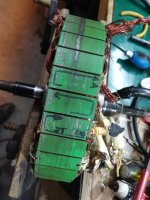
It is quite exhausting to do, the wires are pretty much stuck together. I hope winding will a bit easier than unwinding it (lol I don't think it will).
So far I've successufully removed one and a half phase:
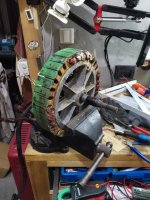
Anyway, it is now time to plan for the rebuild, and since I'm a complete noob I thought I'd ask a few questions before:-
First, wire size:
I have a few options but not sure which one to choose:
-thinner wire? should make winding easier in theory but does it? Could I pack more copper this way? there should be less empty space between winding but more insulation so I'm not sure
-Same wire size? At least I know what to expect this way, but it seems like it's not very easy to work with because it is quite stiff.
-Larger wire size? it will make the winding process a lot harder but then less insulation, less potential failure points, more powah?
-Mixing two wires sizes on the same phase? this way I could have both high infill and high number of paralleled conductors. I've never seen that being done, I had the idea just 10 minutes ago, so I wonder if there is actually a known issue with that. I know that resistances will be different so current will spread unequally, but I assume that since no wire is 100% the same this is also the case even if you use the same wire to make all the windings.
There are also things like skin effect, but they keep saying this only affect windings at "high frequency" without actually defining what high frequency actually is. So does this apply in the case of a hub motor? I'm not sure if the frequencies we're experiencing here are high enough to actually generate skin effect issues, so if anyone has some clear info about that feel free to explain!
Next question would be the wire insulator material. I'd like to get some good stuff, something that can take a lot of abuse. Any suggestion as to what would be a good magnet wire for this application? Also, is there a way to test its properties before so I can make sure I won't discover that it is crap a few days after finishing the project?
Also, I'd like to get some advices from people who have been there already, like Do's and Don'ts.
Like, for instance, it is a good idea to twist the wires a bit before winding? this way thay would stay together during the winding process, but I'm afraid that this would make the phase a little bit longer for no purpose, hence a hgher resistance, plus it would make for a less dense infill.
Is there things to absolutely avoid during winding, like some wires crossing in some bad ways? Are there examples of what is a good vs a bad winding?
Is there a prefered way to start the winding, like is it better to do one phase then the next or should I try to make all the phases at once, coil after coil?
how do I determine how many wires in paralleI can fit for sure? Right now QS managed to fit 54 wires of 0.54mm, but can I fit 55 wires of the same size? I wouldn't want to wind the two first phases only to discover that the last one can't be fitted. Is there a trick ?
One other question: what tools do you guys recommend? I suppose it is quite easy to scratch the insulation with metal ones so I guess wood or plastics is better. Any pictures of the tools you used and their purpose would be greatly appreciated.
Last question for now: do you often scratch the windings while winding? I mean is it something that happens regularly? I which case how do you deal with it? Also, how do you make sure you don't have a short between different turns on the same coil while winding? would suck to finish the whole thing only to discover that one of the coils is shorted to itself. Shorts to the iron core are easy to spot, but shorts within a coil seem a lot more tricky.
I guess that's a lot of questions already but any info you can think of that I haven't mentioned would be really appreciated. Alos links to some good threads would be cool, Ive seen a few but the forum is huge so I guess there are some gems here that I haven't come across.
Thanks a lot in advance for your precious help!
A good friend of mine unfortunately fried his motor recently. It looks like one of the phase partially melted down.
He dropped the motor off to my place yesterday and now I'm trying to see if I can rewire it.
That would be my first time attempting this task, so I thought I'd come here to pick some clever folks brains in order to get as many useful information as possible before trying the rewinding process.
It's a QS 273 rated at 8000W. The goal is to try to make it as powerful as it used to be, or, if possible, even better.
Right now I've started the process of unwinding it, in order to get as many information as I can on its original configuration.

So far it seems like it has 3 turns per tooth, 54 paralleled wires, each of the wires measuring 0.54mm in diameter.
I'm taking notes of the turns orientation and phases numbers by marking them directly on the laminations:

It is quite exhausting to do, the wires are pretty much stuck together. I hope winding will a bit easier than unwinding it (lol I don't think it will).
So far I've successufully removed one and a half phase:

Anyway, it is now time to plan for the rebuild, and since I'm a complete noob I thought I'd ask a few questions before:-
First, wire size:
I have a few options but not sure which one to choose:
-thinner wire? should make winding easier in theory but does it? Could I pack more copper this way? there should be less empty space between winding but more insulation so I'm not sure
-Same wire size? At least I know what to expect this way, but it seems like it's not very easy to work with because it is quite stiff.
-Larger wire size? it will make the winding process a lot harder but then less insulation, less potential failure points, more powah?
-Mixing two wires sizes on the same phase? this way I could have both high infill and high number of paralleled conductors. I've never seen that being done, I had the idea just 10 minutes ago, so I wonder if there is actually a known issue with that. I know that resistances will be different so current will spread unequally, but I assume that since no wire is 100% the same this is also the case even if you use the same wire to make all the windings.
There are also things like skin effect, but they keep saying this only affect windings at "high frequency" without actually defining what high frequency actually is. So does this apply in the case of a hub motor? I'm not sure if the frequencies we're experiencing here are high enough to actually generate skin effect issues, so if anyone has some clear info about that feel free to explain!
Next question would be the wire insulator material. I'd like to get some good stuff, something that can take a lot of abuse. Any suggestion as to what would be a good magnet wire for this application? Also, is there a way to test its properties before so I can make sure I won't discover that it is crap a few days after finishing the project?
Also, I'd like to get some advices from people who have been there already, like Do's and Don'ts.
Like, for instance, it is a good idea to twist the wires a bit before winding? this way thay would stay together during the winding process, but I'm afraid that this would make the phase a little bit longer for no purpose, hence a hgher resistance, plus it would make for a less dense infill.
Is there things to absolutely avoid during winding, like some wires crossing in some bad ways? Are there examples of what is a good vs a bad winding?
Is there a prefered way to start the winding, like is it better to do one phase then the next or should I try to make all the phases at once, coil after coil?
how do I determine how many wires in paralleI can fit for sure? Right now QS managed to fit 54 wires of 0.54mm, but can I fit 55 wires of the same size? I wouldn't want to wind the two first phases only to discover that the last one can't be fitted. Is there a trick ?
One other question: what tools do you guys recommend? I suppose it is quite easy to scratch the insulation with metal ones so I guess wood or plastics is better. Any pictures of the tools you used and their purpose would be greatly appreciated.
Last question for now: do you often scratch the windings while winding? I mean is it something that happens regularly? I which case how do you deal with it? Also, how do you make sure you don't have a short between different turns on the same coil while winding? would suck to finish the whole thing only to discover that one of the coils is shorted to itself. Shorts to the iron core are easy to spot, but shorts within a coil seem a lot more tricky.
I guess that's a lot of questions already but any info you can think of that I haven't mentioned would be really appreciated. Alos links to some good threads would be cool, Ive seen a few but the forum is huge so I guess there are some gems here that I haven't come across.
Thanks a lot in advance for your precious help!


